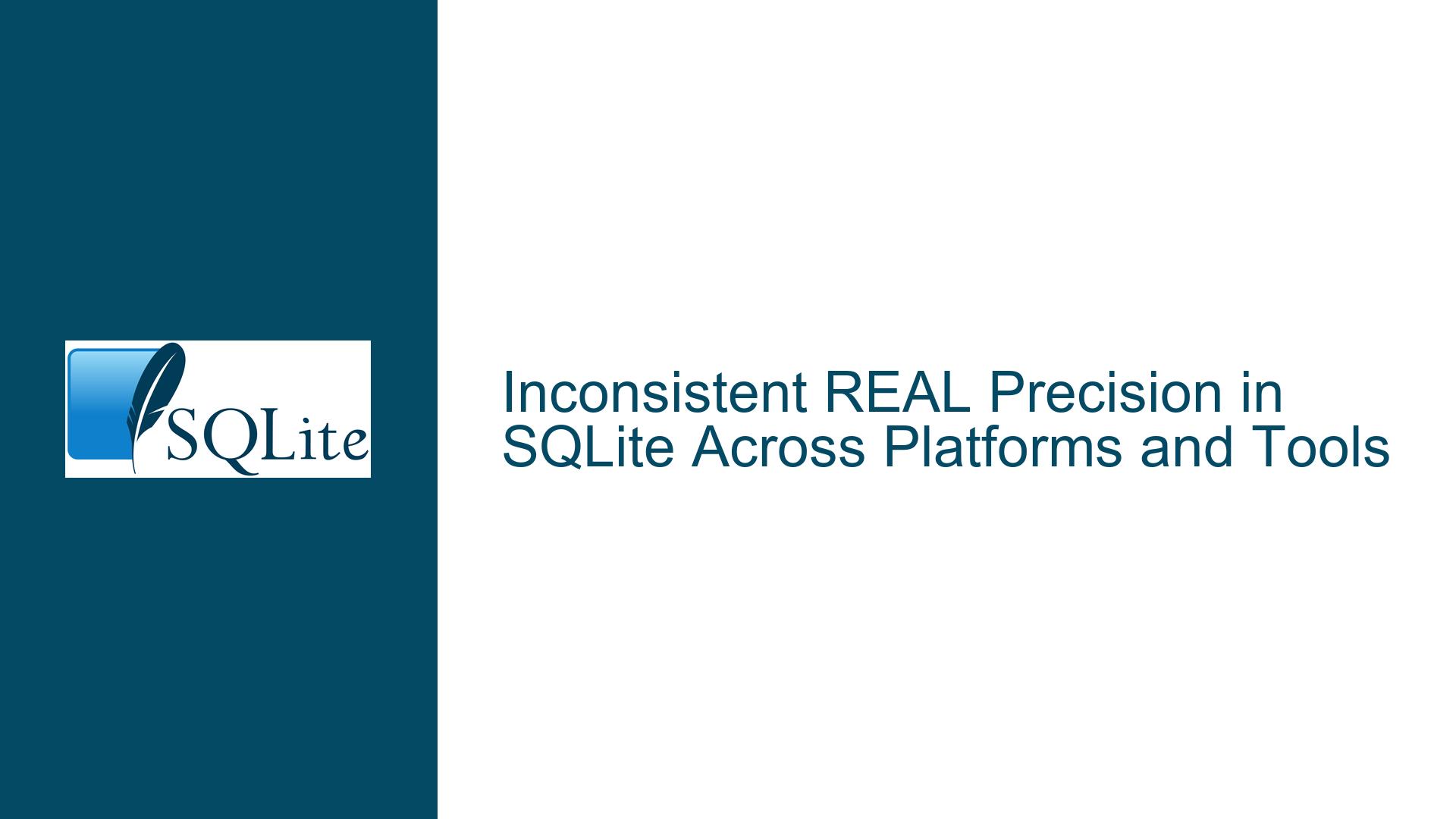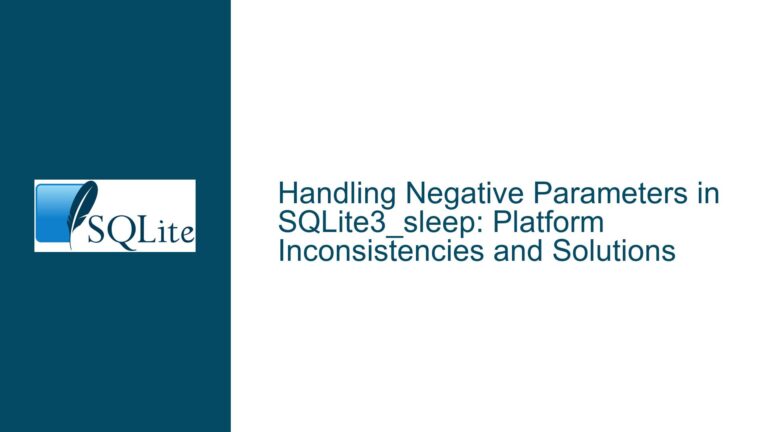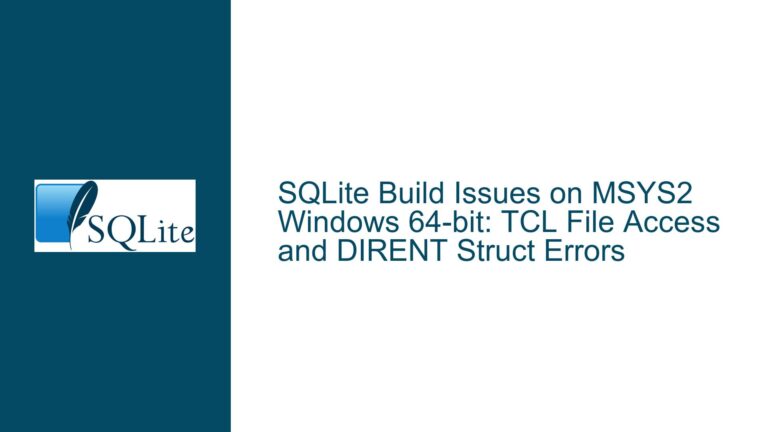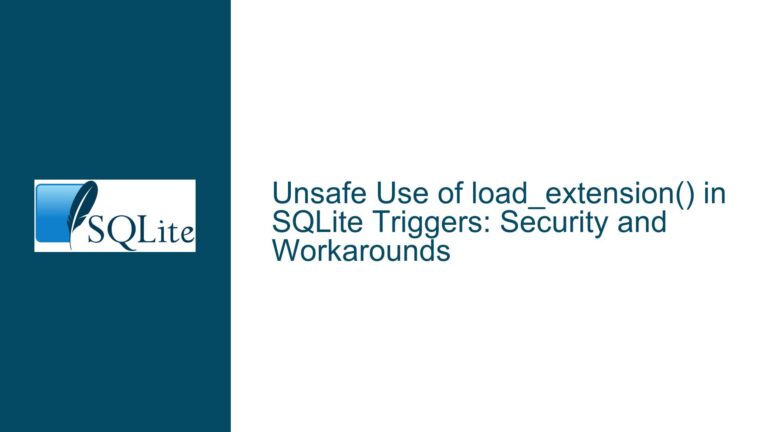Inconsistent REAL Precision in SQLite Across Platforms and Tools
Issue Overview: REAL Data Type Precision Inconsistencies in SQLite
The core issue revolves around the inconsistent handling of the REAL data type in SQLite, particularly when dealing with floating-point numbers. Users have observed discrepancies in how floating-point values are stored, retrieved, and displayed across different platforms (e.g., Linux vs. Windows) and tools (e.g., JDBC drivers, SQLite viewers). For example, inserting the value -4.604223587690774 into a REAL column may result in different stored values depending on the platform or tool used. Some tools store -4.604223587690774, others store -4.6042235876907736, and most store -4.60422358769077. These inconsistencies arise due to differences in how floating-point numbers are converted between their textual representation and their binary representation, as well as platform-specific behaviors in floating-point arithmetic.
The problem is exacerbated by the fact that SQLite internally uses LONG DOUBLE (extended precision) for text-to-real and real-to-text conversions. However, the implementation is inconsistent, with some parts of the conversion code using incorrect constants (e.g., double constants instead of extended precision constants). This leads to inaccuracies in conversions, especially on platforms where extended precision is not supported or is implemented incorrectly. Additionally, Windows x64 processes often set floating-point computation flags incorrectly, resulting in non-IEEE-compliant arithmetic unless specific steps are taken during process initialization.
The issue is not merely academic; it has practical implications for data integrity. For instance, a Java program that writes a double-precision floating-point number to an SQLite database and reads it back may find that the retrieved value does not match the original value. This inconsistency can lead to errors in applications that rely on precise floating-point calculations, such as scientific computing or financial software.
Possible Causes: Floating-Point Conversion and Platform-Specific Behavior
The root cause of the issue lies in the conversion process between textual and binary representations of floating-point numbers. When a floating-point number is inserted into an SQLite database, it can be provided either as a binary value (e.g., via a parameterized query) or as a text string (e.g., in an SQL statement). The conversion from text to binary (and vice versa) is inherently complex and prone to inaccuracies, especially when extended precision is involved.
SQLite uses LONG DOUBLE for these conversions, but the implementation is flawed in several ways. First, the conversion routines use incorrect constants, which introduce inaccuracies. Second, the behavior of these routines varies across platforms due to differences in how extended precision is supported. For example, Windows x64 processes often fail to set floating-point computation flags correctly, leading to non-IEEE-compliant arithmetic. This problem can be mitigated by using non-Microsoft compilers (e.g., GCC), but it requires careful initialization of the process.
Another contributing factor is the way different tools and drivers handle floating-point numbers. Some tools may truncate or round values during insertion or retrieval, leading to further inconsistencies. For example, the JDBC driver for SQLite may behave differently on Linux and Windows due to platform-specific differences in floating-point arithmetic. Additionally, some tools may use their own conversion routines instead of relying on SQLite’s built-in functions, which can introduce additional discrepancies.
The issue is further complicated by the fact that floating-point numbers cannot always be represented exactly in binary. For example, the value -4.604223587690774 cannot be represented exactly as a double-precision floating-point number. The closest representable values are -4.6042235876907736 and -4.6042235876907744. When this value is converted to text and back to binary, the result may differ slightly depending on the conversion routine used. This is why some tools store -4.6042235876907736, while others store -4.60422358769077.
Troubleshooting Steps, Solutions & Fixes: Ensuring Consistent REAL Precision in SQLite
To address the issue of inconsistent REAL precision in SQLite, several steps can be taken. These include modifying the conversion routines, using parameterized queries, and ensuring platform-specific compliance with IEEE floating-point standards.
1. Fixing the Conversion Routines: The first step is to address the flaws in SQLite’s text-to-real and real-to-text conversion routines. This involves replacing the incorrect constants with extended precision constants and ensuring that the routines are consistent across all platforms. If extended precision is not supported on a particular platform, alternative approaches (e.g., using float128) can be used to achieve the necessary precision. This requires modifying the SQLite source code and recompiling it with the appropriate flags.
2. Using Parameterized Queries: To avoid issues with text-to-real conversions, applications should use parameterized queries instead of embedding floating-point values directly in SQL statements. For example, instead of executing INSERT INTO Doubles (data) VALUES (-4.604223587690774), the application should use a parameterized query like INSERT INTO Doubles (data) VALUES (?) and bind the value as a binary double. This ensures that the value is stored and retrieved exactly as intended, without any intermediate text conversions.
3. Ensuring IEEE Compliance on Windows x64: On Windows x64, it is essential to ensure that floating-point computation flags are set correctly during process initialization. This can be achieved by using non-Microsoft compilers (e.g., GCC) or by explicitly setting the flags in the application code. For example, the _controlfp function can be used to set the floating-point control word to ensure IEEE compliance.
4. Testing and Validation: Applications that rely on precise floating-point calculations should include rigorous testing to validate the storage and retrieval of REAL values. This can be done by generating random floating-point numbers, writing them to the database, and verifying that the retrieved values match the original values. The following SQL query can be used to test the conversion routines:
WITH RECURSIVE
randomreal(value) AS NOT MATERIALIZED
(
SELECT random()/9223372036854775808.0 * pow(10, CAST(random()/9223372036854775808.0*308 AS INTEGER))
UNION ALL
SELECT CASE WHEN random() < 0
THEN trunc(random()/9223372036854775808.0 * pow(2, ABS(CAST(random()/9223372036854775808.0*63 AS INTEGER))))
ELSE random()/9223372036854775808.0 * pow(10, CAST(random()/9223372036854775808.0*308 AS INTEGER))
END
FROM randomreal
),
step1(row, value, testformat) AS NOT MATERIALIZED
(
SELECT row_number() OVER (ROWS BETWEEN UNBOUNDED PRECEDING AND CURRENT ROW),
value,
format('%!.17g', value)
FROM randomreal
),
step2(row, value, newvalue, testformat) AS NOT MATERIALIZED
(
SELECT row,
value,
CAST(testformat AS REAL),
testformat
FROM step1
)
SELECT row,
value == newvalue AS success,
COALESCE(SUM(1) FILTER (WHERE value != newvalue) OVER (ROWS BETWEEN UNBOUNDED PRECEDING AND CURRENT ROW), 0) AS badcount,
value,
testformat,
newvalue
FROM step2
WHERE value != newvalue
OR row % 1000000 == 0;
This query generates random floating-point numbers, converts them to text and back to binary, and verifies that the retrieved values match the original values. Any discrepancies are reported, allowing developers to identify and address issues with the conversion routines.
5. Using Alternative Representations: For applications that require exact precision, consider using alternative representations for floating-point numbers. For example, fractional values (stored as a numerator and denominator) can be used to represent real numbers with perfect fidelity. While this approach requires additional storage and computation, it ensures that values are stored and retrieved exactly as intended.
6. Implementing a Strict Mode: SQLite could introduce a "strict mode" for floating-point conversions, where text-to-real and real-to-text conversions are performed using the standard C library functions (e.g., strtod). While this approach may be slower, it ensures that conversions are accurate and consistent across all platforms. This mode could be enabled via a compile-time flag or a runtime option, allowing developers to choose between performance and precision.
By following these steps, developers can ensure that REAL values are stored and retrieved consistently in SQLite, regardless of the platform or tool used. This not only improves data integrity but also enhances the reliability of applications that rely on precise floating-point calculations.






